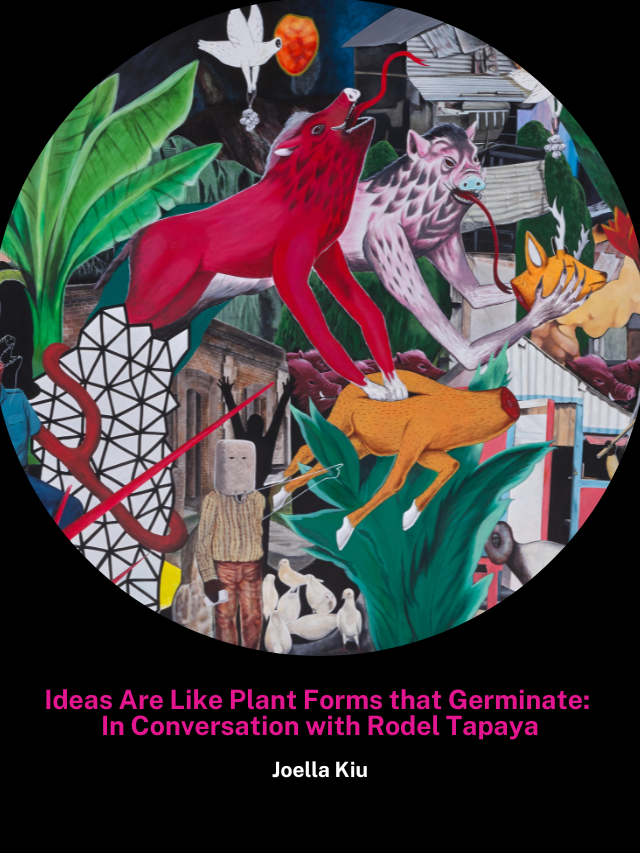Ideas Are Like Plant Forms that Germinate:
In Conversation with Rodel Tapaya
09 May 2023
Stories function as important touch points for a community. Far from being superstition or hearsay, they capture significant moments, encapsulate a socio-philosophical world view, and often impart moral lessons. Keeping these stories alive by passing them on or re-presenting them have been at the heart of contemporary artistic practices such as Tapaya’s. The artist’s large scale canvases or intimate sculptural pieces draw deeply from mythologies and lore that circulate within the context of the Philippines. The following text is an interview with the artist that references works by him that reside within the Singapore Art Museum's collection. This interview was conducted in March 2023.
Let’s start with the way you look towards and incorporate myths and folklore into your works. Mythologies build the world along different lines and within the context of its own logic systems. They can also present us with alternative modes of remembering and understanding the world around us. What do you find most compelling about accessing the world around us through myths, and what do you find yourself drawn to in encountering them (e.g. the characters, the settings, how the stories are transmitted)?
My interest in stories, in myths, particularly, has always been with me, even as a young boy, but I recall investigating folktales, starting with the story of Bernardo Carpio. I learned this, not from reading a book, but from an actual oral story narrated by people in our village. I was fascinated with the idea of the two mountains that were fighting each other, and Bernardo Carpio, the hero of the story and a giant, who tried to appease the two forces. When I hear stories like that, I like to give them form, and I like to illustrate them. I like the surrealness and the larger-than-life quality of the folktales, myths and legends. I think what I find compelling even now is that the myths have a simple yet profound way of explaining complicated topics like war, change, politics, the environment, our beliefs and more.
I also think that these traditional tales are still important today, for it is through stories that we get to better understand our culture, traditions and history. In turn, we learn to appreciate how people in the past could give explanations and stories to different issues and events. Stories have many lessons and are very rich in imagery and detail. A younger generation would benefit from knowing these tales, and I hope they will learn to appreciate our culture through these stories.
Following from that question, I’m also interested in how you gather materials in preparing to make a work. You have often spoken about how research-intensive your practice is. Could you elaborate on how you approach the process of research, especially as a collector of texts, images, stories and reference points?
I try my best to look into different sources of inspiration — sometimes just a proverb, riddle or a game can offer a starting point. I enjoy learning about Filipino culture through stories. I try to explore different genres and find connections to the work I am trying to make, or the theme I am trying to address. I visit publishing houses like the University of the Philippines Press and find books there. Sometimes, I look for secondary sources. There are very few Filipina books in popular bookstores, and this, I hope, will change. I also interview locals, trying to find the stories in their localities that they still remember.
Collage emerges as a salient strategy within your large-scale paintings. In Aswangs Enter the City, for example, aswangs are portrayed alongside wild boars, masked figures and fiery landscapes. In doing so, multiple temporalities are compressed into another, creating a scenario where everything is presented as happening all at once. For me, this recalls the idea of contextual collapse, which is often used to describe how we encounter images on social media that have circulated beyond their original, intended purpose. Has the way we encounter images online changed the way in which you think about collaging images or reference points together?
The two pigs in my work entitled Aswangs Enter the City (2018), are the aswangs. Aswangs are equivalent to the vampires of the Western world; they spread fear and chaos, and look for victims to devour. These aswangs appear as ordinary humans by day, and transform into their vampire state or become aswangs at night. There are many kinds of aswang. There are those who can fly and suck blood out of their victims. Others are able to change into big canines, or boars or pigs. The other flying creatures in the paintings are birds holding garlic, which is known in folk wisdom as an effective antidote against aswangs; these are like missiles to kill the aswang. The birds are not headless — rather, their heads are like those of real people.
Yes, I do use or employ collage as a device in composition. However, I am not really thinking about concepts like contextual collapse when I make compositional studies for work. I am just trying to depict the complexity of the subject and its parallelism to the other ideas I intend to combine. The many patterns and overwhelming details and colours pertain to the Filipino sensibility of ‘horror vacuii,’ or fear of empty space. That’s why the work may appear overwhelming in details, complex. But that has always been the challenge in my creative process, to create a work that will have balance and harmony, despite the chaos and complexities.
These collages act like the ground or environment to the preliminary process of painting. Sometimes the patterns and motifs are not yet unified; they are rather chaotic. I try to just mix and match and the collage pieces are not really related to other elements. After the ground is collaged, I look at it again, to see which of the themes could be possible for this ground. I then scan and print the collage to make drawings overlapping the shapes and colours I’ve created. If I already have a main idea and main figures, I translate them into painting. The process is organic — I let the images and forms tell me what to do. At times, ideas are like plant forms that germinate from small ideas to larger ideas. The visual problem is how to make sense of, or bring order from nothingness and chaos. Through the images I create and connect with other elements, the various motifs unfold, and the complex process is basically the creative process of destruction and creation.
In making these paintings, I’m also interested in how you approach composition. Would you describe your process as a systematic one, where you layer materials atop one another, or do you prefer to work in a randomised, irregular fashion?
Well, it really depends what will work or what I find is interesting for a particular work. But I use different tools, in trying to make studies about a work. Sometimes, I use the aid of images, sometimes words, sometimes ideas. Sometimes, these are done systematically, other times it’s accidental and random. I allow myself to explore and listen to the imagery, while also taking into account the stories that emerge. It’s a complicated process of planning, and in the actual painting process, there are also revelations on what the painting would like to speak about. The process is somewhat structured, and yet also organic in nature.
Your paintings have also been described as “allegorical.” The term “allegory” is often associated with religious and devotional iconography that has been made with a didactic or moralistic purpose in mind. How do you grapple with this historical baggage, within the context of your own work?
As for me, as a visual artist, I use stories, critique and imagery in not very literal ways, but more in a metaphorical way. I let the people look into them, and see for themselves, the messages in the works.
Moving onto a discussion around your diorama works such as Origin of Grain and Pedro and the Witch, the sculptures distill an entire story into a single, key vignette. In that sense, they recall for me how the Stations of the Cross are laid out and function. At the same point in time, the dioramas are not just illustrative depictions. They emphasise texture, tactility and depth. Why was it important for you to visualise these age-old stories through the format of a diorama, and why did you choose to highlight just one moment within each story?
When a story is depicted in diorama form, it just turns into a more real depiction. Mostly the ones turned into dioramas in museum settings are historical events and natural history. For the diorama series I made, I tried to challenge if the myths and folktales could be in diorama form. They also resemble retablos, or altar pieces.

You’ve also worked deftly across various scales — from the life-sized to the very intimate. What are some of the main considerations for you when it comes to scale, and do you follow certain guiding principles in making these decisions?
I like the idea and feeling that when I make large-scale works (mostly in landscape and panoramic format), I somehow became part of the painting. The scale is larger than life and the viewer also has a feeling of being part of the work. I was fascinated early on with maps — how a town that is depicted in macro view can also be seen in micro view, with little streets and characters in that town — the way that you can view a particular place from a distance, and yet, you are also able to zoom in on the details. When I paint, I put in so many details into the composition, that you can look at it in both the macro view and micro view.
Your practice has always been characterised by the enmeshing of our contemporary world with different beings, realities and histories. As we conclude, I wanted to wrap up with a question that hopes to shed light on why this perspective has stayed with you, over the years. What do you think is the enduring place of the fantastical or imaginary in the face of tragedy and urgency?
There are simple stories that can better explain complex things; there are also stories referred to as truth, that can complicate our understanding. Myths, legends, parables, folktales may be fantasy or just imaginary for some. However, I believe that they offer a simpler, and yet more powerful way to help us humans make sense and find meaning in our existence.
Artist Bio
Rodel Tapaya (b. 1980, Montalban, Philippines) works in media ranging from monumental paintings to intricate sculptures and traditional craft, to create work that synthesises folk narratives, pre-colonial historical research and contemporary reality, within the framework of memory and history.
Author Bio
Joella Kiu is Assistant Curator at the Singapore Art Museum.


